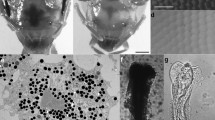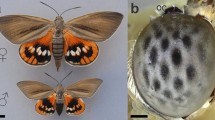Summary
The compound eyes ofPieris brassicae L. have a tiered retina. During light and dark adaptation, ultrastructural changes have been observed throughout the length of the ommatidia in the latero-ventral region of the eyes. These changes have been quantitated by mapping at distinct levels of the ommatidia, and plotted as histograms. Both in visual cells and secondary pigment cells and at the attachment region between crystalline cone and rhabdome such ultrastructural changes have been found to be correlated to the state of adaptation.
Distal and proximal photoreceptor cells show different adaptation mechanisms. Whereas the distal cells show a clear pupil mechanism in their distal parts, there is only very little horizontal movement of pigment granules in the proximal cells. In the proximal cells, multivesicular bodies (MVB) are always abundant, while in the distal cells their number is small and increases slightly during light adaptation. In the proximal cells light adaptation causes pigment granules, located in the distal process, to move proximally. Increasing the light intensity from 160 to 1600 μW/cm2 results in more intense migration of pigments.
In the secondary pigment cells, a slight but significant distal movement of pigment granules is observed at high light intensity. If continued this condition causes the granules to aggregate in the vicinity of the apical cell membrane, and to move up to the distal inflated extensions of the distal processes formed by these cells. In dark adapted eyes, these processes are nearly devoid of pigment and the pigment granules beneath the apical membrane disperse. In addition to these structural changes, there is a tendency for retinal movements at the attachment from crystalline cone to rhabdome. — The various adaptation mechanisms are not equally well developed in different regions of the compound eye.
Zusammenfassung
Die Retina vonPieris brassicae L. ist mehrreihig. Erstmals wurden feinstrukturelle Veränderungen während der Hell und Dunkeladaptation über die gesamte Länge der Ommatidien des latero-ventralen Augenbereichs anhand von Kartierungen in vergleichbaren Höhen der Ommatidien untersucht und in Histogrammen wiedergegeben. — Sowohl in den Sehzellen als auch Nebenpigmentzellen und am Übergang von Kristallkegel zum Rhabdom wurden feinstrukturelle Veränderungen in Korrelation mit der Adaptation gefunden.
Die Adaptation erfolgt bei distalen und proximalen Sehzellen jeweils auf andere Art. Während die distalen Sehzellen in ihrem distalsten Bereich sehr gut die Pupillenreaktion zeigen, adaptieren die proximalen Sehzellen nur geringfügig mit horizontaler Pigmentwanderung. Auch die Anzahl der multivesikulären Körper (MVB), die in den proximalen Sehzellen immer groß ist, steigt bei Helladaptation (HA) nur in den distalen Sehzellen etwas an. In den proximalen Sehzellen wandern die Pigmentgranula bei HA geringfügig aus dem distalen Fortsatz dieser Sehzellen proximalwärts. Intensitätssteigerung auf das 10fache (von 160 auf 1600μW/cm2) bewirkt eine Verstärkung der genannten Pigmentwanderungs-Reaktionen in den Sehzellen.
Die Granula der Nebenpigmentzellen wandern bei HA mit starker Intensität etwas distalwärts. — Bei starker langer HA häufen sich diese Granula unter der apikalen Membran dieser Nebenpigmentzellen und wandern bis in die distalen kleinen Erweiterungen der distalen Fortsätze dieser Zellen. Bei Dunkeladaptation (DA) sind diese Fortsätze nahezu frei von Pigment; unter der apikalen Zellmembran verteilen sich die Pigmente locker. Außerdem besteht am Übergang von Kristallkegel zu Rhabdom die Tendenz zur Retinomotorik. — In den verschiedenen Augenbereichen erfolgen die genannten Adaptationsreaktionen unterschiedlich gut.
Similar content being viewed by others
Literatur
Exner, S.: Die Physiologie der facettierten Augen von Krebsen und Insekten. Leipzig-Wien: Verlag F. Deuticke 1891
Franceschini, N., Kirschfeld, K.: Le contrâle automatique du flux lumineux dans l'oeil composé des Diptéres. Propriétés spectrales, statiques et dynamiques du mécanisme. Biol. Cybernetics21, 181–203 (1976)
Kolb, G., Autrum, H.J.: Die Feinstruktur im Auge der Biene bei Hell- und Dunkeladaptation. — J. comp. Physiol.77, 113–125 (1972)
Kolb, G.: The structure of the eye ofPieris brassicae L. (Lepidoptera). Zoomorphologie87, 123–146 (1977)
Kolb, G.: Zur Rhabdomstruktur des Auges vonPieris brassicae L. (Insecta, Lepidoptera). — Zoomorphologie91, 191–200 (1978)
Menzel, R., Lange, G.: Änderungen der Feinstruktur im Komplexauge vonFormica polyctena bei der Helladaptation. — Z. Naturforsch.26b, 357–359 (1971)
Ribi, W.A.: Ultrastructure and migration of secreening pigments in the retina ofPieris rapae L. (Lepidoptera, Pieridae). Cell Tissue Res.191, 57–73 (1978)
Ribi, W.A.: Coloured screening pigments cause red glow hue in Pierid butterflies. — J. comp. Physiol.132, 1–9 (1979)
Richardson, K.C., Jarett, L., Finke, E.H.: Embedding in epoxy resins for ultrathin sectioning in electron microscopy. Stain Technol.35, 313–323 (1960)
Sato, S.: On the dimensional characters of the compound eye ofCulex pipiens var. P. (Morphological studies of the compound eye in the Mosquito). — The Science Reports of the Tohoku University, 4. Series Biol. Vol.23, No. 2, 83–90 (1957)
Schümperli, R.A., Swihart, S.: Spatial properties of dark-and light-adapted visual fields of butterfly interneurons. J. Insect Physiol.24, 777–784 (1978)
Stavenga, D.G.: Visual adaptation in butterflies. — Nature254, 435–437 (1975)
Stavenga, D.G., Numan, J.A.J., Tinbergen, J., Kuiper, J.W.: Insect pupil mechanisms. II. Pigment migration in retinula cells of butterflies. J. comp. Physiol.113, 73–93 (1977)
Swihart, S.L., Gordon, W.C., Machwart, R.J.: Reflections on the eyes of butterflies. J. Insect Physiol.20, 359–381 (1974)
Walcott, B.: Cell movement on light adaptation in the retina ofLethocerus (Belostomatidae, Hemiptera). — Z. Vgl. Physiol.74, 1–16 (1971)
Yagi, N., Koyoma, N.: The compound eye of Lepidoptera. Approach from organic evolution. — Shinkyo-Press & Co. Ltd. 1963
Author information
Authors and Affiliations
Additional information
Mit Unterstützung der Deutschen Forschungsgemeinschaft und der Stiftung Volkswagenwerk
Herrn Prof. Dr. Kurt Hamdorf (Bochum) danken wir für kritische Diskussion und Fräulein Althaus für die graphischen Darstellungen
Rights and permissions
About this article
Cite this article
Kolb, G., Schwarz, G. Hell-und Dunkeladaptation der Augen vonPieris brassicae L. (Lepidoptera). Zoomorphologie 94, 265–278 (1980). https://doi.org/10.1007/BF00998205
Received:
Issue Date:
DOI: https://doi.org/10.1007/BF00998205




